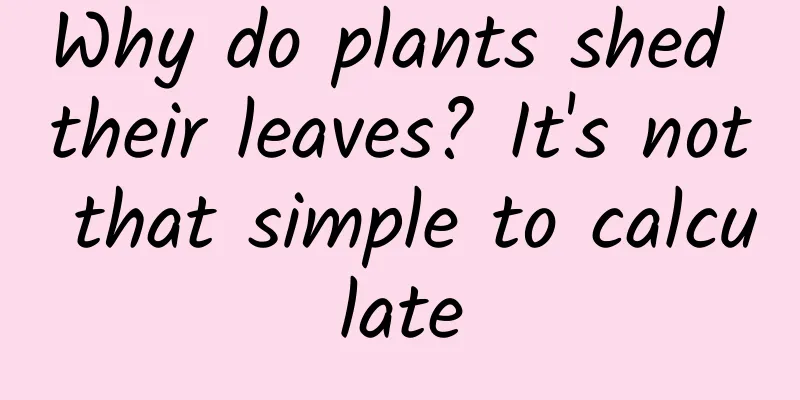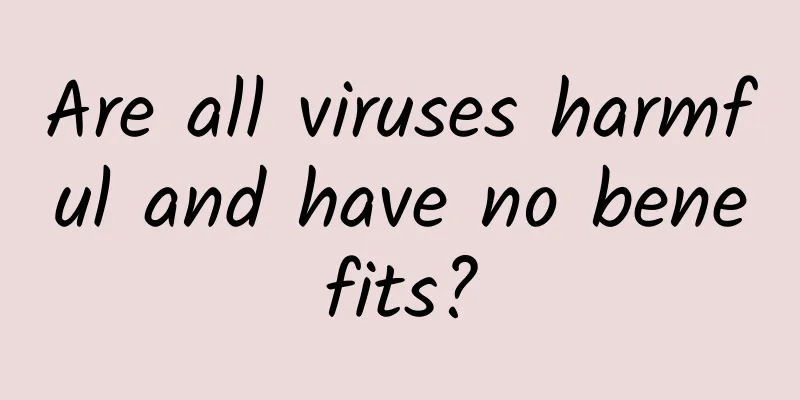Why do plants shed their leaves? It's not that simple to calculate

|
Poets can't help but feel sad when facing the sight of falling leaves in autumn. But my favorite is Li Bai's poem: "The grass does not thank the spring breeze for its growth, and the trees do not complain about falling in autumn. Who whips the four elements to drive the four cycles? All things rise and fall naturally." Indeed, only nature can drive this scenery of reincarnation. Today, I will talk to you about the nature behind the falling leaves. Part 1 Do plants only lose their leaves in autumn? No, there are two ways for leaves to fall. For most trees, the main function of leaves is to produce "food". Like animals, plants also need to consume sugars to maintain physiological functions. The only difference is that animals rely on eating, while plants mainly rely on sunlight to produce it themselves. Therefore, in the ecosystem, plants are generally also called "producers" and animals are called "consumers". How can such an important organ be thrown away? Of course, it was a last resort. The first situation is that the leaf dies. Leaves are also living things, they also have to go through birth, aging, illness and death, or accidents. For example, they may be torn, broken, hit by the Moonlight Box, or simply die of old age. At this time, the dead leaves have no physiological functions and have to be discarded. Therefore, even evergreen trees will shed their leaves due to this situation. However, the leaves of evergreen trees die and fall at any time, and it is impossible for all the leaves to fall at the same time, so there will be no situation where all the leaves are bald like deciduous trees (post-90s). The second situation is that the environment in which the tree grows has changed for the worse, so it can only choose to shed its leaves. These changes include drought, extreme high and low temperatures, pests and diseases, etc. Although leaves are important, they are not so important in terms of saving lives. This is like a nuclear power plant accident. Although there are many important factories and buildings on the surrounding land, they must all be abandoned for the sake of life safety. This is the so-called "active leaf drop when encountering adversity." In winter, trees cannot carry out physiological activities in extremely low temperatures, so they must hibernate. If we want to stop the operation of a factory, we just need to cut off the electricity. However, the "electricity" used by the leaf factory is sunlight, which cannot be cut off. Therefore, they have to be discarded by falling leaves. Source: Mou Fupeng Part 2 Fallen leaves: Protecting flowers even before they turn into spring mud After the fallen leaves leave, they fall at the feet of the big trees, and through a series of physical and chemical reactions they are transformed into nutrient-rich humus and are reabsorbed by the roots. This is what is called fallen leaves returning to their roots. But scientists have discovered that, in fact, before falling, the fallen leaves have already begun their dedication. And all of this can be traced back to the evolution of plants. Hundreds of millions of years ago, the ancestors of plants were all species that lived in water. Later, the earth experienced several ice ages and the sea level dropped, so plants had to "land". The biggest problem faced by plants after landing was lack of water. In order to effectively use the pitiful amount of water in the soil, plants grew roots to fix themselves in the soil. Although this solved the water problem, it also brought new problems: lack of nutrients such as nitrogen, phosphorus and potassium. Why? Because water is equivalent to a "renewable resource", it can be replenished by precipitation after it is consumed. But it is impossible to rain nitrogen, phosphorus and potassium compound fertilizers when it rains, right? So these substances are "non-renewable resources". After they are consumed, plants can't uproot and escape, so they can only worry. Source: Mou Fupeng Part 3 There are two solutions One is to increase revenue, the other is to reduce expenditure. How to open source? Pitcher plants and Venus flytraps are good examples. They are predators in the plant world, using their deformed leaves to catch insects (and even other small animals, such as the pitcher plant in the picture below that is "eating" a fly). Insects are high in protein and can supplement nitrogen for plants. This is one of the extreme ways plants have evolved to get more nitrogen. Nepenthes preys on flies (Source: Wikipedia) For example, legumes have nodules on their roots, which are nitrogen factories. In the nodules, plants share some of their sugars with rhizobia, and in return, rhizobia can convert nitrogen in the air into nitrogen that plants can use. This is also an example of plants opening up new sources of income. How to save money? It’s about minimizing waste. As we mentioned earlier, plants will actively shed their leaves to protect themselves when they are subjected to adversity such as cold. When leaves fall, the nutrients contained in the leaves are lost. This is a huge waste for plants. Although they will become humus for use next year. But this is not very safe, for example, fallen leaves are blown away by the wind or eaten by animals. So the best way is to quickly dismantle and recycle all the recyclable things inside before the leaves fall, and store them in the trunk, especially non-renewable substances such as nitrogen, phosphorus and potassium. Therefore, the dedication of fallen leaves to "protect flowers" does not begin after turning into spring mud, but before they fall. It has already begun. Why are plants so stingy that they don't even spare abandoned leaves? In other words, they are "afraid of being poor." What's more, taking the root nodules we mentioned above as an example, when soybeans are about to mature in the fall, since their own growth cycle is almost over, they know that they don't need so much nitrogen, so they cut off the nutrient supply of the nodules, cruelly starving to death the rhizobia that work for them, dismantling and absorbing their corpses along with the nodules, and transporting the nutrients to the soybean seeds. Having written this, I can't help but sigh that although plants seem weak, they are also very capable of doing anything to adapt to nature! This makes us truly understand the word "evolution". Part 4 Red Makeup: The Last Performance We know that before the leaves fall in autumn, the leaves of deciduous trees will change from green to red or yellow. The red leaves of maple trees are also a brilliant scenery in late autumn. This is not because they are about to be abandoned and dyed with random colors, but the makeup that plants carefully prepare for the leaves they are about to abandon. In autumn, ultraviolet rays are not necessarily weaker than in summer. This is because there are fewer clouds and the air is dry in autumn. Although the sunlight is not as toxic, less ultraviolet rays are reflected by clouds and absorbed by water. Although plants rely on sunlight to survive, they can also be sunburned by ultraviolet rays. Red or yellow is the sunscreen that plants apply to themselves. Some friends will definitely ask: Why don’t the leaves change color in summer? This is because in the summer, the leaves need to give full play to their function of producing nutrients. If you apply sunscreen, it is equivalent to blocking the sunlight, and the production efficiency is affected. In the summer, plants have another set of methods to fight ultraviolet rays, which I will not elaborate on here. However, in autumn, the leaves of plants gradually stop growing, so it doesn't matter if they are not exposed to the sun, so it's better to be simple and violent and use the method of painting to protect against the sun. In addition, the leaves of many tropical plants are red when they first grow out, because immature leaves need sun protection. The same is true when they gradually mature and can work, and then they will fade away. Moreover, in the autumn, when plants disassemble the recyclable materials in the leaves and carry them back to the trunk, they will produce a lot of "decoration waste", which is free radicals. Free radicals are toxic substances. The sunscreen pigments in red leaves also have the function of scavenging free radicals, which can prevent the leaves from being poisoned by free radicals before they are completely disassembled. In addition, some scientists believe that compared with green, red and yellow are less attractive to herbivores. Plants choose these two colors to tell herbivores "don't eat me, I'm not delicious" to prevent themselves from being eaten. So, the little matter of falling leaves is really simple but not easy. It gets colder in winter, so leaves fall off; and since nutrients are non-renewable, plants must recycle nutrients in their leaves before they fall off; in order to ensure the smooth completion of this recycling process, plants produce pigments to act as sunscreen. Aren’t all these measures taken by plants to adapt to nature? After reading this article, friends must have a deeper understanding of the opening sentence "Who whips the four elements to drive the four movements? All things rise and fall naturally." Produced by: Science Popularization China Author: Mou Fupeng Producer: Computer Network Information Center, Chinese Academy of Sciences The article only represents the author's views and does not represent the position of China Science Expo This article was first published in China Science Expo (kepubolan) Please indicate the source of the public account when reprinting Please indicate the source of the reprint. Reprinting without authorization is prohibited. For reprint authorization, cooperation, and submission matters, please contact [email protected] |
<<: Why are there only No. 1, 5, and 7 batteries, but no No. 4, 8, 9, and 10?
>>: Huaxi doctors warn you to be careful when eating crabs! Especially this may be life-threatening
Recommend
Do you know all the events of the Beijing Winter Olympics? The most comprehensive popular science is here →
There are 15 days left until the opening of the B...
A new channel for emergency treatment! Drones outperform ambulances in “flash delivery” →
Compiled by: Gong Zixin Out-of-hospital cardiac a...
[Collection] The secrets behind Apple's search ads are revealed, with the most complete and detailed explanation and step-by-step setup tutorial (official video attached)
The WWDC2016 Search Ads session video and PPT have...
Good news: Typhoon Makar is gone! Bad news: It’s coming again…
In the past two days, the super typhoon "Mak...
GSMA: China's 5G vertical industry application cases in 2022
2021 is a critical year for 5G to achieve initial...
Teach you a quick and brainless method to write original articles, the fastest way to write original articles!
Let me explain the principle. First, combine 58.c...
Who cut the budget?
One phenomenon is that nowadays, clients are incr...
Mel Gibson's film "Apocalypse" HD 1080P English subtitles
"Apocalypse" is a fantasy adventure act...
How does a new media director write a promotion plan?
Today’s topic is how to write a promotion plan fo...
Is it true that "a dragon gave birth to nine sons"? There is fossil "evidence" | Bolan Daily
Is it true that “a dragon gives birth to nine son...
Data Operations: How can operations train their data thinking?
What does “data sensitive” mean? You may have bee...
Go exercise in the spring, but be careful, the harder you exercise, the more "injured" you will be...
Take off the down jacket! The woolen coat is off!...
OV's performance has exploded with impressive growth, but there are hidden concerns amid the prosperity
Recently, the US research company IDC released th...
As Siberia continues to warm, is the disappearance of the tundra inevitable?
Siberian tundra could disappear within 500 years?...
“Soul” product operation analysis!
Social needs are the third need based on physiolo...









